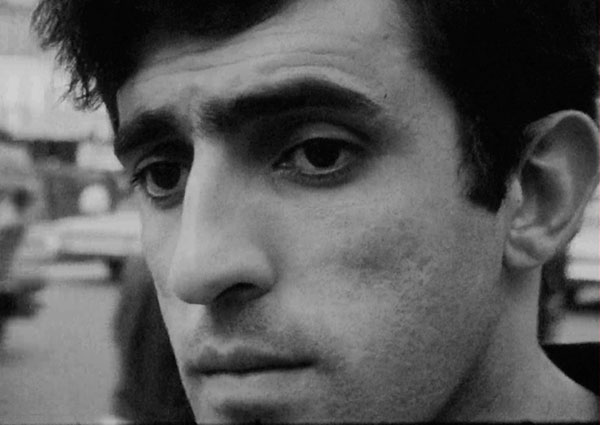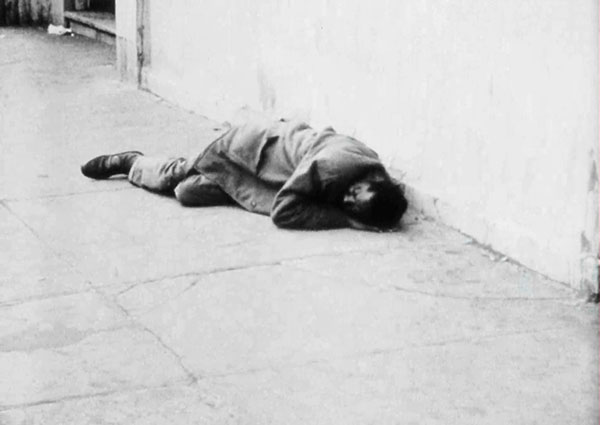
A minuscule mutation
What happened that Sunday afternoon in Paris towards the end of the 90s? A shock. That caused by the screening, organised by the journal Trafic at Jeu de Paume, of Peter Emanuel Goldman’s Echoes of Silence. ‘The strangest film in the world,’ as they used to say then; defended by Mekas, by Godard, banned by French censors between 1967 and 1970, premiered on the sly in the summer of 1970 to later fall into oblivion. Its title, the most beautiful in the world, made us dream. In 1997 I even copied on a school notebook the magnificent lines that Jean-Claude Biette had dedicated to it in Cahiers du Cinéma in March 1967 – the last bonds linking us to that invisible film, a remake of which I dreamt of shooting at that time, based only on the statements provided by Biette’s critique: ‘The order and number of the sequences does not appear to matter much. Each chapter or canvas is interrupted by its duration itself: the looks exchanged by the three girls in a small room do not lead anywhere and keep within themselves, latent, a drama that never comes to break out. Nothing happens to these beings lost in New York. Nothing is resolved; all that is perceived is a minuscule mutation, and the film progresses by amplification, as a latent ode – by the engulfing addition of solitudes.’*[1]
I can still feel today that ‘engulfing’ solitude Biette talked about. I can see myself again coming out of the screening, shaken, getting on the underground. There were other young cinema enthusiasts on the train; I had never spoken to them, and some of them would later become major filmmakers: Serge Bozon, Axelle Roppert, Julien Husson. We stared at each other without speaking, as if marking in that silence our membership in a secret society: the sect of those who have seen Echoes of Silence. The film still kept its hold on us. It made us hear its intimate violence. We had taken a vow of silence.
I can still hear the rain that beat against the windows of the above-ground train that day. Soaked to the bone, I was shaking. I had become them: Miguel, Stasia, Viraj, all dazed, walking wildly across the streets of Greenwich Village, our eyes consumed by emotional starvation. Being 20 is some indescribable shit. Just too bad that cinema has always told us otherwise. Moreover, Echoes of Silence was made on the fringes of cinema. Everything was said on the title card already, drawn by hand by the filmmaker himself, by way of introduction; a page from a private diary suddenly projected on too large a screen: ‘This photo is of a house in a quiet section of New York’s Greenwich Village. I lived in the apartment on the third floor. The second floor apartment was first occupied by Stasia. When she left, Miguel became the tenant. They never met each other though they haunted the same cafes and had some of the same friends. Vraj lived where he could. Occasionally he visited Stasia. Sometimes I would accompany them with my camera. That’s how this film came into being.’
His gesture? To keep a daily record of the chronicles of a handful of young beatniks navigating the hollow anonymity of an ogre city: New York. New York and its grand idea of democracy, meaning the masses. And what would this utterly American notion of the masses be if it was not inevitably accompanied by all that solitude spread out? What Echoes of Silence refuses to do is to see passing bodies and faces gradually disappear. It wants to snatch them from the masses that swallow them. New York is a vampire city and Miguel wanders across New York as a romantic Nosferatu. Behind him, Charles Mingus’ double bass beats and howls.
A few weeks later, at the end of a lecture at the Cinémathèque, Jean-Claude Biette showed an unknown short film by Goldman, Pestilent City, made in 1965, a few months after Echoes of Silence. Yet another cry of rage tossed at the throat of New York, shot as an inhumane city, in slow motion and in the negative. More and more, Goldman appeared to me as a loony Murnau coming from the night of time, bringing again to the 60s – with the violence of youth culture and the brutality of underground – the great debates between silent cinema, the cinema of the force of the face, and photography, the power of still images. Goldman is a filmmaker of the masses, of the wandering, of the flowing, and at the same time a filmmaker of frames, of images that suddenly stand still out of exhaustion, as a result of the condensation of affects.
It was then necessary to do some research, to inquire, to find out who that guy was, how that cinema outside the rules could have possibly emerged, in a situation of virtually total unawareness.
This we found out: Peter Emanuel Goldman had graduated in English and History from Brown University in Providence. He moved to Paris in 1960 to study History at the Sorbonne. In 1961, he enrolled in Berkeley but spent most of his time in a boxing gym. Then he joined a vessel that took him to Venezuela. Upon his return, his father gave him an 8 mm camera. In 1962, he went back to Paris and wrote about art in the Paris Herald Tribune. In late 1962, back in New York, he shared a flat in Greenwich Village. He bought a Bolex 16 mm camera with a winding crank and started shooting the girls and boys, whether anonymous people or friends, who dropped by this flat. This is how Echoes of Silence was born. The film, obsolete, cost a mere 50 cents per unit. Miguel, the hero of the movie, was initially working as an electrician for the film. The montage was made at night; the music was taken from among the records scattered across the flat: Stravinsky’s The Rite of Spring, Prokofiev’s suite Semyon Kotko, Charles Mingus’ Haitian Fight Song. Susan Sontag saw the film in early 1965 and was enthusiastic about it. Goldman showed the film in SoHo, during the evening sessions at the Film-Makers’ Coop. Jonas Mekas wrote about Echoes of Silence in The Village Voice and the film was selected at the Pesaro Film Festival in Italy, a breeding ground for ‘young cinema’. The film premiered in New York in a 35 mm copy. The French premiere was banned by censors. Italy, in turn, censored the film. Goldman also shot in 1964-65 several short films that now appear to be totally lost, including Recommended by Duncan Hines or Night Crawlers. Only Pestilent City, shot on 42nd Street and Times Square, was saved. In 1965, for a total of $10,000, Goldman shot The Sensualists, a sexploitation film commissioned by Stanley Borden, a producer of films intended for the movie theatres on 42nd Street. Nothing but some fragments remain from the film. Goldman married a young Danish woman, Birgit Nielsen, who had a role in Wheel of Ashes, his third feature film, which he shot in Paris in 1967-68 thanks to a grant he received through Jean-Luc Godard. The film, shot in seven weeks with Pierre Clémenti in the main role, reflects a mystic crisis. Pierre Clémenti, who, just as so many French people at that time, did not speak English, understood the title in a totally different way: ‘We Love Hashish.’
Cold sun. Paris 1968 coated in a frozen light, a milky way paved with girls and spectres. The walking man is the sleeping man’s brother. Their lethargic sleepwalking, their paranoid wandering, is hindered by visions: visions of idols, of legs in tight leather sheaths. The sixties were discovering miniskirts and thigh boots. Walking on the street was becoming meaningful again. So he walks, his eyes open, stunned: ‘But I can feel the spring, and with the spring I smell women.
He haunts the cafés until love takes over. He walks and walks, carrying his loneliness towards the hardest end. Walking, bumping into the city ghosts, drawing the first lesson from it: the walking man, the wandering man, the drugged man, the mystic man, the madman are all advanced states of the same revelation. So he walks empty in a supernaturalist state; he stays in the parks, waiting, as an exterminated, emaciated angel, his gaze flying across the shop windows in Saint-Germain, dragging himself across the Cinéacs, the peepshows, the bohemian vapours of the library Shakespeare and Company. He walks into a cinema: they are showing Paranoia by Adrian Ditvoorst and the girl next to him is wearing a miniskirt – distraction and temptation. His walk ends in a short-time hotel on rue Saint-Denis, love at one hundred francs.
Wheel of Ashes is the private diary of an American lost in Paris, with Pierre Clémenti as Peter Emanuel Goldman’s double, the two of them learning to become ‘the true man’, searching for elevation. ‘They tell me I stray too far from reality. The only reality I know is chaos.’
In Echoes of Silence, Peter Emanuel Goldman had summed up New York in a series of isolated silences. In Wheel of Ashes, he searches for love, he begins his mystic crisis, he films the stagnation in a hotel room by the Bastille. The street is filled with ashes as the reel of the film unrolls and becomes thinner. Will the Angel come? And the woman? And the child? Born again, will he wait to be dazed?
After this crisis, Peter Emanuel Goldman lived in an ashram in France first, to later leave for Denmark and Israel. He never shot a film again.
Philippe Azoury
[1] Jean-Claude Biette, Cahiers du Cinéma, 188, March 1967

Echoes of Silence
Assistants: Riva Freifeld, Michael Sheridan
Music: Charles Mingus, Igor Stravinsky, Serge Prokofiev, Pete Seeger.
Cast: Miguel Chacour, Stasia Gelber, Viraj Amonsin
Echoes of Silence focuses on three young people in Greenwich Village, Miguel, Stasia and Viraj, and their aimless wandering and searching for meaning and sex in an oppressive New York.

Pestilent City
Assistant: Birgit Bogh Nielsen
A Dantesque portrait of an alienated metropolis. Goldman’s New York is certainly not Woody Allen’s New York.

The Sensualist
Katrina leaves her home in Denmark after an unhappy love affair and comes to New York where she meets Sharon, a Greenwich Village coffee house waitress, who offers the shelter of her apartment.
This sexploitation film, unfortunately lost, and never seen again after 1968, was shot in different styles, sometimes imitating Godard, Bergman, Truffaut or Bertolucci. The producer hated it and Brian DePalma wrote a funny article about it in the Village Voice. All that remains of it is a 35mm trailer and 8 reels of 16mm work print without sound that we are presenting in a special screening with the support of La Cinémathèque Française.
This session also includes: Goldman’s earlier shorts Recommended by Duncan Hines (1963, 4 min) and Nightcrawlers (1963, 4 min).

Wheel of Ashes
Producer: Stephen Ujlaki
Cinematography: Tristan Burgess, Pierre-William Glenn, Peter Emanuel Goldman
Editing: Joële Van Effenterre
Music: Hugh Robertson, Olivier Taïariol
Drawings: Stasia Gelber, Pierre Besançon
Cast: Pierre Clémenti, Katinka Bo, Pierre Besançon, Richard Leblanc, Juliet Berto
A haunted and alienated young man, played by Pierre Clémenti, attempts to find God through Eastern mysticism by cutting himself off from the world: Instead, he becomes the focus of a terrible inner struggle between his mystical and sexual natures and the love of a young woman.

